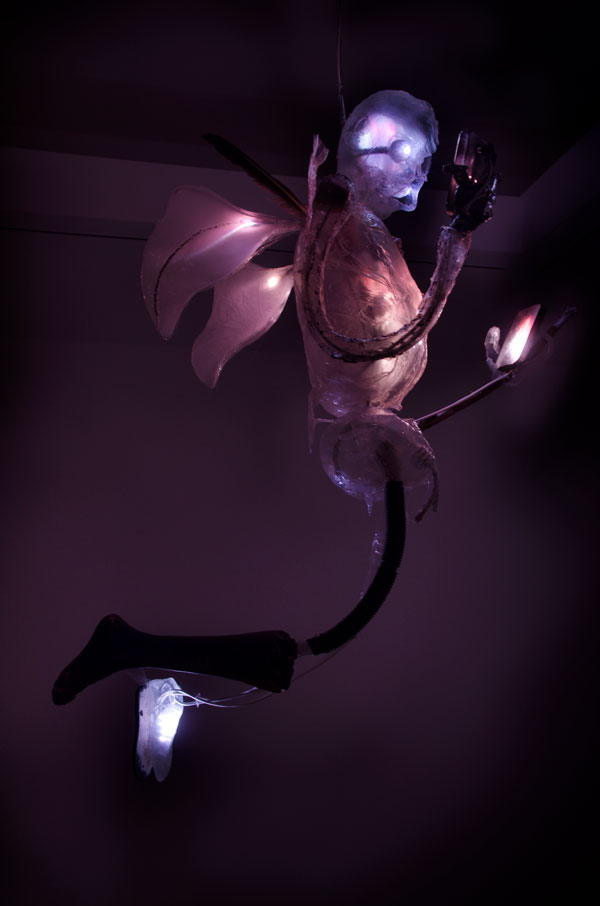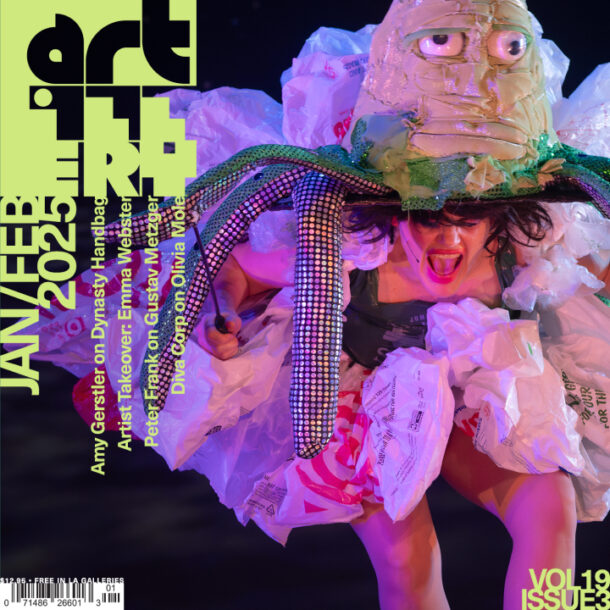Danial Nord’s solo installation at the Torrance Art Museum, Cloud Nine (2018), presents translucent human-like sculptures, lit by LEDs responding to social media and video feeds. Nord fire-casted clear polycarbonate sheets into the shapes of recognizable figures hunched over their cellphones—the Businessman, Gunman, Mother, Alien, Illegal and Angel—and installed them in a darkened room set against electronic sounds. The video footage is determined by an algorithm that converts them into light, brightening each of Nord’s figures and making indissoluble the human body from its technology-driven needs.
These plastic and metal figures are also stuck with found objects and beach driftwood that reference the natural world of yesteryear. Cloud Nine depicts bodies as non-medium specific, in a Rauschenberg combine-like twist on the human body. The Angel possesses wings and floats by wires, displaying a satirical levitation. Another figure appears to either levitate or hang from the ceiling by a noose. It looks like a celestial ghost liberated by technology that grants an eternal stream of information.
In this installation, Nord muddles life-and-death distinctions, and this central complication might be the most interesting aspect of Cloud Nine: what happens when knowledge becomes over-prioritized, way above other psychological needs like face-to-face connection and real life relationships? Will our data-driven virtual world ultimately lead to the dissolution and death of what makes us human?
Nord’s artworks are both public and private: they reflect personal introspections on our increasing reliance on data-driven industries and the Internet. Nord also jumped through bureaucratic hoops to make these figures: Parks and Recreation, the Port of LA, City of LA Fire Department and Life Guard Department approved Nord’s fire-casting to sculpt the plastic on South Bay beaches. Nord’s figures are roped together by internal mechanics and external bureaucracies, suggesting what the human body relies on for short-term survival, which leads to irrevocable long-term dependencies.
In her 2009 article “Race As Technology,” for Camera Obscura, media studies theorist Beth Coleman discusses how the tools we use to wield power in this world and augment our six senses (think of contact lenses that are now 3D printable) become an extension of who we are. These tools are prosthetic: they allow us to more easily navigate the world and shape how we express ourselves. As a prosthetic tool, the internet provides mental space for online communities to exist. From Men’s Rights movements to Gun Control advocates, such communities reinforce, insulate and protect belief systems, giving them life and longevity. Nord’s work reinforces this implication: pulsing with data, the prosthetic limb becomes the entire corporeal self. In its quest for information, the human body has taken the complete computational form of circuits and plastic—making it more than just cyborgian, but totally unrecognizable. One might recall Yeats’ ambivalence about another kind of revolution: “He too, has resigned his part / In the casual comedy; / He too, has been changed in turn, / Transformed utterly: / A terrible beauty is born.”



